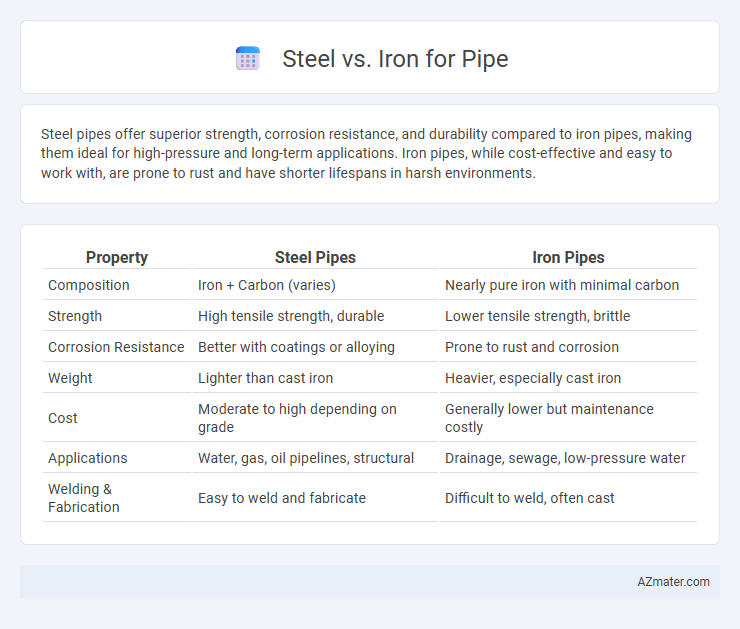Steel pipes offer superior strength, corrosion resistance, and durability compared to iron pipes, making them ideal for high-pressure and long-term applications. Iron pipes, while cost-effective and easy to work with, are prone to rust and have shorter lifespans in harsh environments.
Table of Comparison
| Property | Steel Pipes | Iron Pipes |
|---|---|---|
| Composition | Iron + Carbon (varies) | Nearly pure iron with minimal carbon |
| Strength | High tensile strength, durable | Lower tensile strength, brittle |
| Corrosion Resistance | Better with coatings or alloying | Prone to rust and corrosion |
| Weight | Lighter than cast iron | Heavier, especially cast iron |
| Cost | Moderate to high depending on grade | Generally lower but maintenance costly |
| Applications | Water, gas, oil pipelines, structural | Drainage, sewage, low-pressure water |
| Welding & Fabrication | Easy to weld and fabricate | Difficult to weld, often cast |
Introduction to Steel and Iron Pipes
Steel pipes, known for their high strength, durability, and corrosion resistance, are widely used in industries requiring robust pressure-bearing capabilities, such as oil and gas, construction, and water transportation. Iron pipes, primarily cast or ductile iron, offer excellent rigidity and resistance to wear but are more prone to corrosion and heavier than steel alternatives. The choice between steel and iron pipes depends on factors like mechanical strength, cost, environmental conditions, and specific application requirements in infrastructure and industrial systems.
Key Differences Between Steel and Iron
Steel pipes offer higher tensile strength and corrosion resistance compared to iron pipes, making them more durable for industrial applications. Iron pipes, particularly cast iron, are more brittle and prone to rust, limiting their use in high-pressure systems. The alloy composition in steel, primarily carbon mixed with iron, enhances flexibility and weldability, whereas iron pipes are usually more rigid and heavier.
Common Applications of Steel Pipes
Steel pipes, known for their high tensile strength and corrosion resistance, are widely used in construction, oil and gas transportation, and water supply systems. Common applications include structural support in buildings and bridges, high-pressure fluid conveyance in refineries and pipelines, and HVAC systems due to their durability and reliability. Steel's ability to withstand extreme temperatures and pressures makes it preferable over iron, especially in industrial and infrastructure projects.
Typical Uses of Iron Pipes
Iron pipes, particularly cast iron and ductile iron, are commonly used in water and sewage systems due to their excellent corrosion resistance and ability to withstand high pressure. These pipes are favored in municipal infrastructure for drainage, stormwater management, and potable water transport. Iron pipes' durability and strength make them suitable for underground installations where longevity and reliability are critical.
Strength and Durability Comparison
Steel pipes offer superior strength compared to iron pipes, with a higher tensile strength allowing them to withstand greater internal pressures and external forces. The durability of steel is enhanced by its resistance to cracking and corrosion, especially when coated or galvanized, making it ideal for long-term applications in harsh environments. Iron pipes, while strong, are more brittle and prone to rust, reducing their lifespan and performance under stress.
Corrosion Resistance: Steel vs Iron
Steel pipes, especially those made from stainless or galvanized steel, offer superior corrosion resistance compared to iron pipes due to the presence of chromium and protective coatings. Iron pipes, particularly cast iron, are more prone to rust and corrosion when exposed to moisture and oxygen, leading to a shorter lifespan in corrosive environments. This makes steel pipes the preferred choice for applications requiring durability and resistance to environmental degradation.
Cost and Affordability Analysis
Steel pipes generally have a higher upfront cost compared to iron pipes due to their enhanced strength, corrosion resistance, and longer lifespan. Iron pipes, while cheaper initially, often incur increased maintenance and replacement expenses over time, affecting their overall affordability. Evaluating total lifecycle cost reveals steel as a more cost-effective option for long-term infrastructure projects despite higher initial investment.
Maintenance and Longevity Factors
Steel pipes demonstrate superior longevity compared to iron pipes due to their enhanced resistance to corrosion and higher tensile strength, reducing the frequency of repairs. Maintenance requirements for steel pipes are generally lower, as protective coatings and galvanization minimize rust formation and structural degradation. Iron pipes, particularly cast iron, are more prone to cracking and corrosion over time, necessitating more frequent inspections and replacements to ensure system reliability.
Environmental Impact and Sustainability
Steel pipes have a lower environmental impact compared to iron pipes due to their higher recyclability and longer lifespan, reducing the need for frequent replacements and resource extraction. The production of steel emits fewer greenhouse gases per ton than iron, contributing to lower carbon footprints in construction applications. Sustainable steel manufacturing practices, such as using electric arc furnaces and recycled scrap, further enhance steel pipes' eco-friendliness in infrastructure projects.
Which Pipe Material Is Right for Your Project?
Steel pipes offer superior strength, durability, and resistance to high pressure, making them ideal for industrial applications and long-term projects. Iron pipes, while more affordable and corrosion-resistant in certain environments, tend to be heavier and less flexible, which may limit their use in complex plumbing systems. Assess project requirements such as pressure tolerance, environmental exposure, and budget to determine whether steel or iron pipes provide the best balance of performance and cost-efficiency.

Infographic: Steel vs Iron for Pipe
 azmater.com
azmater.com